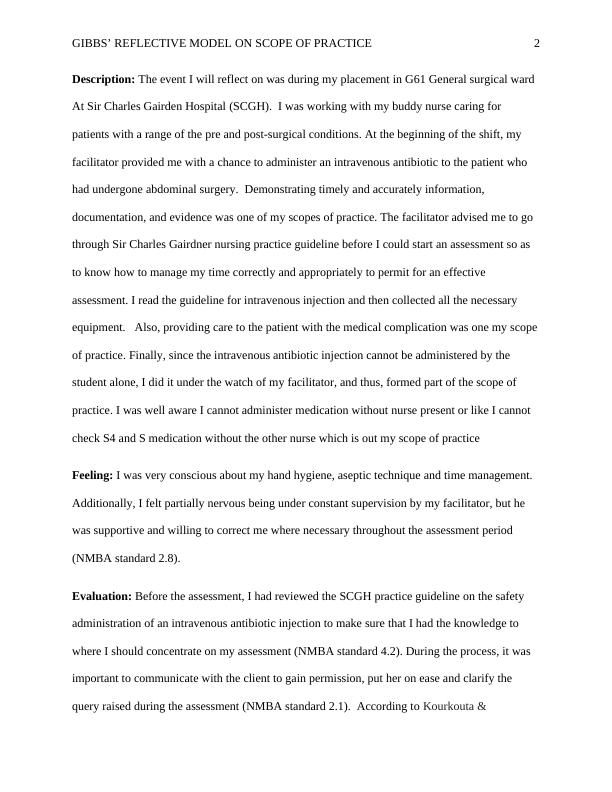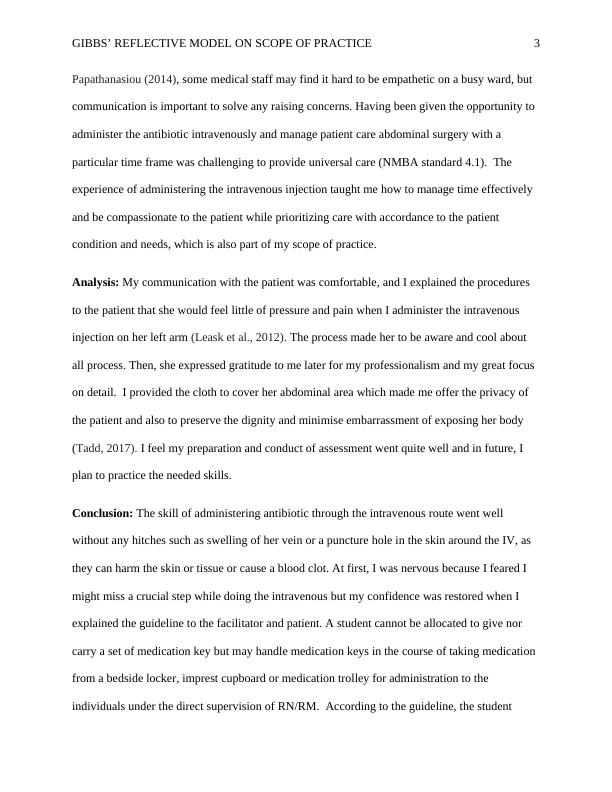Gibbs' Reflective Model on Scope of Practice
Added on 2023-06-03
6 Pages1133 Words376 Views
Running head: GIBBS’ REFLECTIVE MODEL ON SCOPE OF PRACTICE
1
Gibbs' reflective model on the scope of practice
Name:
Institution:
1
Gibbs' reflective model on the scope of practice
Name:
Institution:

GIBBS’ REFLECTIVE MODEL ON SCOPE OF PRACTICE 2
Description: The event I will reflect on was during my placement in G61 General surgical ward
At Sir Charles Gairden Hospital (SCGH). I was working with my buddy nurse caring for
patients with a range of the pre and post-surgical conditions. At the beginning of the shift, my
facilitator provided me with a chance to administer an intravenous antibiotic to the patient who
had undergone abdominal surgery. Demonstrating timely and accurately information,
documentation, and evidence was one of my scopes of practice. The facilitator advised me to go
through Sir Charles Gairdner nursing practice guideline before I could start an assessment so as
to know how to manage my time correctly and appropriately to permit for an effective
assessment. I read the guideline for intravenous injection and then collected all the necessary
equipment. Also, providing care to the patient with the medical complication was one my scope
of practice. Finally, since the intravenous antibiotic injection cannot be administered by the
student alone, I did it under the watch of my facilitator, and thus, formed part of the scope of
practice. I was well aware I cannot administer medication without nurse present or like I cannot
check S4 and S medication without the other nurse which is out my scope of practice
Feeling: I was very conscious about my hand hygiene, aseptic technique and time management.
Additionally, I felt partially nervous being under constant supervision by my facilitator, but he
was supportive and willing to correct me where necessary throughout the assessment period
(NMBA standard 2.8).
Evaluation: Before the assessment, I had reviewed the SCGH practice guideline on the safety
administration of an intravenous antibiotic injection to make sure that I had the knowledge to
where I should concentrate on my assessment (NMBA standard 4.2). During the process, it was
important to communicate with the client to gain permission, put her on ease and clarify the
query raised during the assessment (NMBA standard 2.1). According to Kourkouta &
Description: The event I will reflect on was during my placement in G61 General surgical ward
At Sir Charles Gairden Hospital (SCGH). I was working with my buddy nurse caring for
patients with a range of the pre and post-surgical conditions. At the beginning of the shift, my
facilitator provided me with a chance to administer an intravenous antibiotic to the patient who
had undergone abdominal surgery. Demonstrating timely and accurately information,
documentation, and evidence was one of my scopes of practice. The facilitator advised me to go
through Sir Charles Gairdner nursing practice guideline before I could start an assessment so as
to know how to manage my time correctly and appropriately to permit for an effective
assessment. I read the guideline for intravenous injection and then collected all the necessary
equipment. Also, providing care to the patient with the medical complication was one my scope
of practice. Finally, since the intravenous antibiotic injection cannot be administered by the
student alone, I did it under the watch of my facilitator, and thus, formed part of the scope of
practice. I was well aware I cannot administer medication without nurse present or like I cannot
check S4 and S medication without the other nurse which is out my scope of practice
Feeling: I was very conscious about my hand hygiene, aseptic technique and time management.
Additionally, I felt partially nervous being under constant supervision by my facilitator, but he
was supportive and willing to correct me where necessary throughout the assessment period
(NMBA standard 2.8).
Evaluation: Before the assessment, I had reviewed the SCGH practice guideline on the safety
administration of an intravenous antibiotic injection to make sure that I had the knowledge to
where I should concentrate on my assessment (NMBA standard 4.2). During the process, it was
important to communicate with the client to gain permission, put her on ease and clarify the
query raised during the assessment (NMBA standard 2.1). According to Kourkouta &

GIBBS’ REFLECTIVE MODEL ON SCOPE OF PRACTICE 3
Papathanasiou (2014), some medical staff may find it hard to be empathetic on a busy ward, but
communication is important to solve any raising concerns. Having been given the opportunity to
administer the antibiotic intravenously and manage patient care abdominal surgery with a
particular time frame was challenging to provide universal care (NMBA standard 4.1). The
experience of administering the intravenous injection taught me how to manage time effectively
and be compassionate to the patient while prioritizing care with accordance to the patient
condition and needs, which is also part of my scope of practice.
Analysis: My communication with the patient was comfortable, and I explained the procedures
to the patient that she would feel little of pressure and pain when I administer the intravenous
injection on her left arm (Leask et al., 2012). The process made her to be aware and cool about
all process. Then, she expressed gratitude to me later for my professionalism and my great focus
on detail. I provided the cloth to cover her abdominal area which made me offer the privacy of
the patient and also to preserve the dignity and minimise embarrassment of exposing her body
(Tadd, 2017). I feel my preparation and conduct of assessment went quite well and in future, I
plan to practice the needed skills.
Conclusion: The skill of administering antibiotic through the intravenous route went well
without any hitches such as swelling of her vein or a puncture hole in the skin around the IV, as
they can harm the skin or tissue or cause a blood clot. At first, I was nervous because I feared I
might miss a crucial step while doing the intravenous but my confidence was restored when I
explained the guideline to the facilitator and patient. A student cannot be allocated to give nor
carry a set of medication key but may handle medication keys in the course of taking medication
from a bedside locker, imprest cupboard or medication trolley for administration to the
individuals under the direct supervision of RN/RM. According to the guideline, the student
Papathanasiou (2014), some medical staff may find it hard to be empathetic on a busy ward, but
communication is important to solve any raising concerns. Having been given the opportunity to
administer the antibiotic intravenously and manage patient care abdominal surgery with a
particular time frame was challenging to provide universal care (NMBA standard 4.1). The
experience of administering the intravenous injection taught me how to manage time effectively
and be compassionate to the patient while prioritizing care with accordance to the patient
condition and needs, which is also part of my scope of practice.
Analysis: My communication with the patient was comfortable, and I explained the procedures
to the patient that she would feel little of pressure and pain when I administer the intravenous
injection on her left arm (Leask et al., 2012). The process made her to be aware and cool about
all process. Then, she expressed gratitude to me later for my professionalism and my great focus
on detail. I provided the cloth to cover her abdominal area which made me offer the privacy of
the patient and also to preserve the dignity and minimise embarrassment of exposing her body
(Tadd, 2017). I feel my preparation and conduct of assessment went quite well and in future, I
plan to practice the needed skills.
Conclusion: The skill of administering antibiotic through the intravenous route went well
without any hitches such as swelling of her vein or a puncture hole in the skin around the IV, as
they can harm the skin or tissue or cause a blood clot. At first, I was nervous because I feared I
might miss a crucial step while doing the intravenous but my confidence was restored when I
explained the guideline to the facilitator and patient. A student cannot be allocated to give nor
carry a set of medication key but may handle medication keys in the course of taking medication
from a bedside locker, imprest cupboard or medication trolley for administration to the
individuals under the direct supervision of RN/RM. According to the guideline, the student

End of preview
Want to access all the pages? Upload your documents or become a member.
Related Documents
Gibb’s Reflection on IV Medication Administration in Clinical Placementlg...
|5
|1074
|479
Reflections in Clinical Practices Assignmentlg...
|4
|958
|38
Assignment on Medical Surgical Nursinglg...
|6
|1645
|57
Gibb’s Reflective Cycle Analysis 2022lg...
|6
|1716
|17
Nursing Questions and Answers Assignmentlg...
|21
|4840
|44
Reflections in Nursing Clinical Practicelg...
|5
|925
|51
